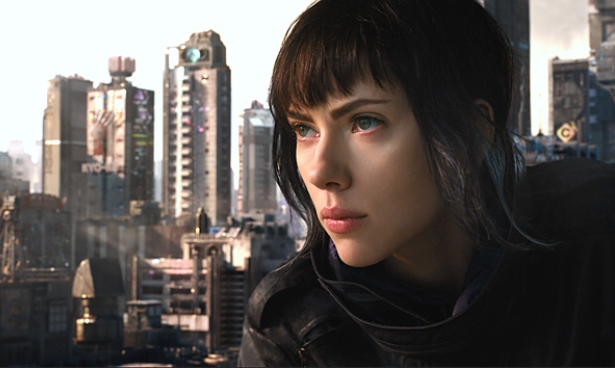
If you are looking for an example as to how American movies can contribute to the dumbing down of culture or dumbing down of movies in general made and sold for international audiences, Ghost in the Shell is not the ultimate example, but it surely is a applicable example to bring up. I saw a tantalizing opening credits sequence, the kind the promises that it’s going to heady dystopian sci-fi, and quickly gathered that the movie itself – a narrative hodgepodge from numerous other sci-fi sources – was an empty shell.
I’ve had it with Scarlett Johansson taking so many action heroine parts, although it must be made clear that her “Lucy” (2014) where she plays a dumb mafia moll given a serum that makes her a super-intelligent being who uses up to 100 percent of her brain power, had a fanciful imagination to it. Johansson invests herself in this part, she is lissome and vigorous in action, but to what end? “Ghost in the Shell” is based on a hugely popular Japanese manga, and I have to guess the original source has its merits as well as the original anime, since even fanboys seem to have already dissed how watered down and incoherent this American version is.
As the story begins, Major (Johansson) has had a brain transplant put in a robotic body so that it can be used to fight a chain of uninteresting crime lords and bad guys, and soon we learn, she’s the first of its kind to be this half-human / half-machine hybrid. The entire picture is depressingly dystopian, which would be fine if it said something. The whole mucky world of “Ghost in the Shell” is synthetic, non-vegetative, wall-to-wall digital. They never talk about suicide rates in these futuristic worlds, but I think they ought to start doing that.
The only emotionally supple performance is by Juliette Binoche, the great French actress who obviously came in for a paycheck, but at least supplied me with relief playing the robot architect designer and mentor to Major (my attention came alive). With the guys, well there’s Takeshi Kitano (sorry, I’ve never been a fan although I know he’s big in the Asia shoot ’em up genre), there’s Michael Pitt as a fellow sorry man/machine who knows “the truth” and a dozen bunch of other hardcore soldiers who seem to live for gunfights and nothing else. Like, nothing else. No backstories that suggest they have families, other ambitions, or whatever.
The script, in-between countless gun battles, waxes poetic about the defining attributes of identity. But I find its’ ideas don’t mesh well with what I learned in much better films like “Dark City” or “Blade Runner,” per se. In its brief moments where it dares to say anything, “Ghost in the Shell” goes thud.
100 Minutes. Rated PG-13.
SCI-FI & FANTASY / MINDLESS / BAD MOVIES WE HATE
Film Cousins: “Blade Runner” (1982); “Ghost in the Shell” (1986); “Akira” (1988); “Cloud Atlas” (2012).





